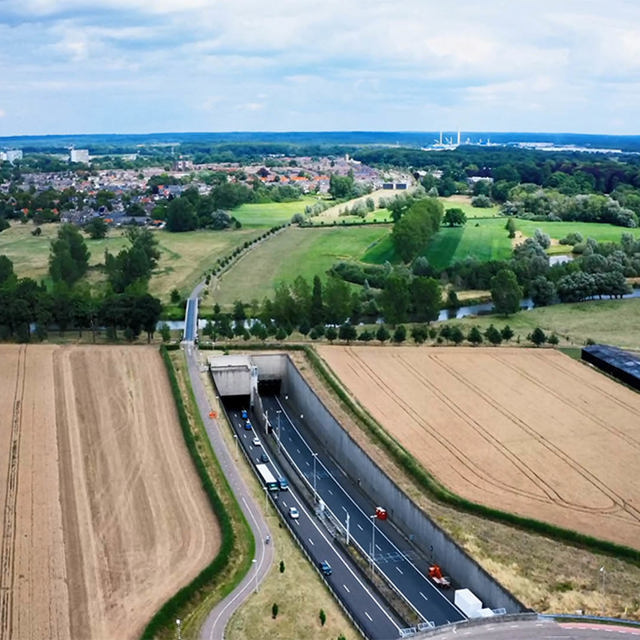How to ensure successful collaboration in a complex process?
The combination of Croonwolter&dros and Ballast Nedam, known as the A73 Combination, is responsible for the long-term maintenance of the Roertunnel and Tunnel Swalmen on the A73. In 2023 and 2024, they also carried out major replacements and renovations (R&R) of various civil components and tunnel technical installations. Collaboration between parties was crucial in this process. What factors contributed to its success?
One contract for maintenance and R&R
The approach chosen by Rijkswaterstaat was Maintain, Design, Construct, Maintain (MDCM). In 2022, the A73 Combination started the first M: after a six-month transition period - to gain object knowledge in collaboration with the then maintenance contractor - maintenance was taken over. From the start, the long-term maintenance team and the R&R team worked together to gather all the knowledge needed to come up with a design (the D of Design from the MDCM contract) for the R&R of installations that had reached the end of their lifespan. During the period from the 2023 summer closure to the 2024 summer closure, the bulk of the realisation (the C of Construct) took place. The R&R team then completed construction and will bid farewell once all documentation regarding the R&R is also complete. Thereafter, the long-term maintenance team will continue with the final M until at least mid-2027.
Two blood groups, one goal
With this approach, Rijkswaterstaat wanted to prevent a new party from doing the R&R, and leaving again without worrying about its impact on maintenance. After all, the interests of a long-term maintenance team and a R&R team differ. A long-term maintenance team wants a tunnel available safely at all times and is focused on eliminating any risk that threatens this goal. A R&R team wants to deliver the right quality on time and within budget. With choosing one contractor combination for both tasks, good cooperation between the two teams with opposing interests is not a given.

Better dialogue
Lieuwe Gietema of Ballast-Nedam is project manager on behalf of the A73 Combination. 'At the start, we soon noticed how both disciplines are used to thinking from their own interests. As a result, we drew up a manifesto designating the long-term maintenance team as the tunnel's caretaker. They facilitate and monitor the R&R team and, in some cases, help carry out work. We also rigged a new consultation structure that ensured better dialogue and understanding of each other's interests and problems. After that, both teams worked as one and the benefits of working together became visible.'


Thinking from the interests of Rijkswaterstaat
A good example of this is the choice of new sustainable LED lighting in the escape corridors, the middle tunnel channel and the service buildings. More economical and easier-to-install solutions were also available for this. However, the teams chose to propose to Rijkswaterstaat a type of LED lighting that requires a higher investment, but pays for itself quickly due to its low energy consumption and long lifespan. Michel Meels, Maintenance Engineer at Croonwolter&dros: ‘These are benefits that the R&R team has no interest in and, given the contract duration, limit our long-term maintenance team, but are certainly in the client's interest. Rijkswaterstaat therefore chose this more expensive and sustainable option. Thus, this example also immediately illustrates the good cooperation with Rijkswaterstaat.'
No unnecessary work
Another example of how both teams and Rijkswaterstaat thought together from ‘best for project’ concerns the application of a new, durable light-reflective top layer on the asphalt. To do this, the old top layer had to be milled away. The narrow strip along the barrier - between which there were also several gullies for water drainage - was difficult to remove and it would also take a lot of work to reapply it. This involved a narrow strip of asphalt totalling 1.6 km over which a car tyre would never drive. In consultation with Rijkswaterstaat, it was decided not to replace these narrow strips, but to grit them with a light-reflecting agent. A significant gain, with no loss of quality.
The 2-phase approach reduces discussions
Another factor contributing to the successful cooperation between the client and the A73 Combination was the 2-phase approach that Rijkswaterstaat used for this project. At the end of phase 1, after working out the final design, the contractor is allowed to revise its price - within the framework of the contract. Phase 1 focuses together on minimising uncertainties and risks.
Two parties working as one
Finally, there is the integral cooperation between Croonwolter&dros and Ballast Nedam within the contractor combination. This is secured through the establishment of a joint venture in which both parties are fifty per cent shareholders and in which the scope of the contract is not split. Both parties are responsible for the total. ‘This works well for such a complex project where you don't want a discussion about who has specific responsibility for part of the scope,’ says Martijn Marijnen, Manager Asset Management at Croonwolter&dros. 'There are too many dependencies that you cannot all predict in advance. Meanwhile, within Croonwolter&dros, we are working on a maintenance organisation that is not only organised per project, but also nationwide. This allows knowledge gained on projects to be better shared in communities of practice. Ballast Nedam employees, involved in the long-term maintenance of the A73 tunnels, are also participating in this with great interest.'
A73 tunnels now meet national tunnel standard
From the summer of 2023 to the end of 2024, the asphalt, crucial installations such as CCTV, the speed underrun system (SOS), ventilators, traffic systems and lighting were renewed. The new systems were connected to the old control system via a coupling PLC. The remaining tunnel systems, including civilian components, were replaced or upgraded. After this operation, the new systems in the A73 tunnels comply with the national tunnel standard (LTS).







